The Intel Skylake-X Review: Core i9 7900X, i7 7820X and i7 7800X Tested
by Ian Cutress on June 19, 2017 9:01 AM ESTBenchmarking Performance: CPU Rendering Tests
Rendering tests are a long-time favorite of reviewers and benchmarkers, as the code used by rendering packages is usually highly optimized to squeeze every little bit of performance out. Sometimes rendering programs end up being heavily memory dependent as well - when you have that many threads flying about with a ton of data, having low latency memory can be key to everything. Here we take a few of the usual rendering packages under Windows 10, as well as a few new interesting benchmarks.
Corona 1.3
Corona is a standalone package designed to assist software like 3ds Max and Maya with photorealism via ray tracing. It's simple - shoot rays, get pixels. OK, it's more complicated than that, but the benchmark renders a fixed scene six times and offers results in terms of time and rays per second. The official benchmark tables list user submitted results in terms of time, however I feel rays per second is a better metric (in general, scores where higher is better seem to be easier to explain anyway). Corona likes to pile on the threads, so the results end up being very staggered based on thread count.
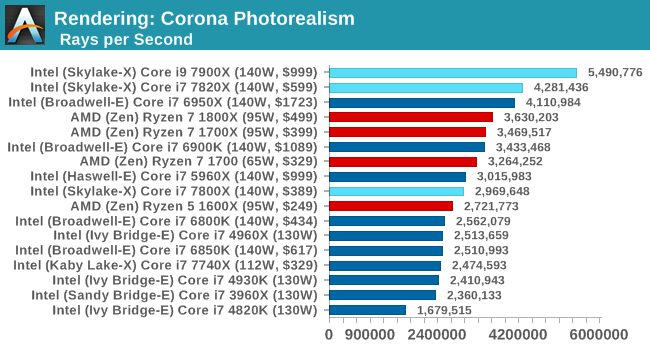
Blender 2.78
For a render that has been around for what seems like ages, Blender is still a highly popular tool. We managed to wrap up a standard workload into the February 5 nightly build of Blender and measure the time it takes to render the first frame of the scene. Being one of the bigger open source tools out there, it means both AMD and Intel work actively to help improve the codebase, for better or for worse on their own/each other's microarchitecture.
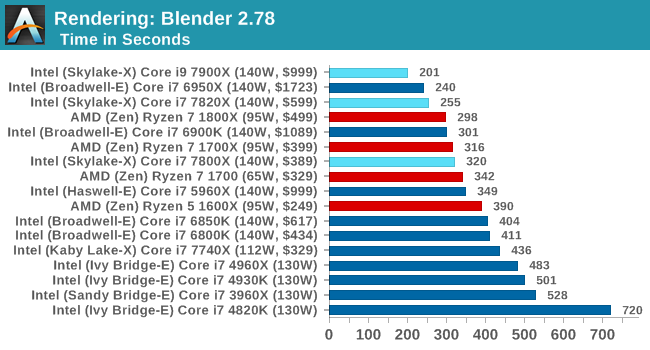
LuxMark
As a synthetic, LuxMark might come across as somewhat arbitrary as a renderer, given that it's mainly used to test GPUs, but it does offer both an OpenCL and a standard C++ mode. In this instance, aside from seeing the comparison in each coding mode for cores and IPC, we also get to see the difference in performance moving from a C++ based code-stack to an OpenCL one with a CPU as the main host.
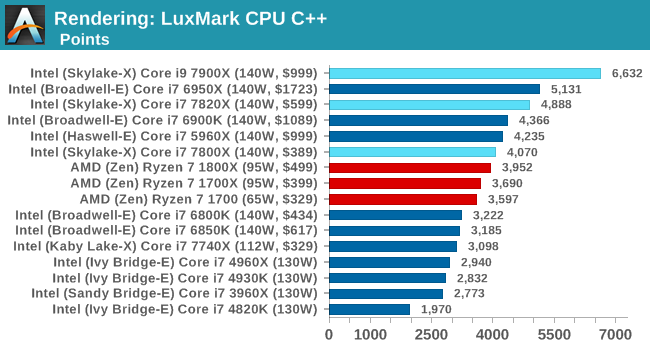
POV-Ray 3.7b3
Another regular benchmark in most suites, POV-Ray is another ray-tracer but has been around for many years. It just so happens that during the run up to AMD's Ryzen launch, the code base started to get active again with developers making changes to the code and pushing out updates. Our version and benchmarking started just before that was happening, but given time we will see where the POV-Ray code ends up and adjust in due course.
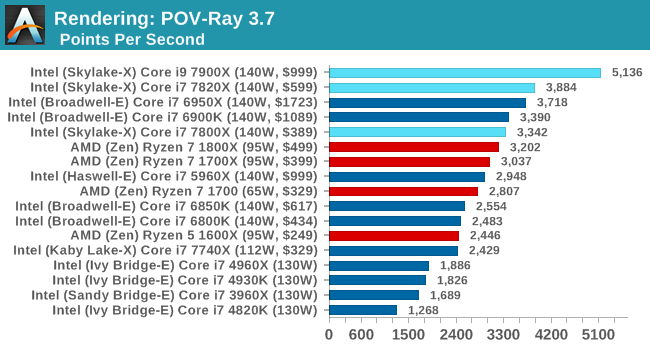
Cinebench R15
The latest version of CineBench has also become one of those 'used everywhere' benchmarks, particularly as an indicator of single thread performance. High IPC and high frequency gives performance in ST, whereas having good scaling and many cores is where the MT test wins out.
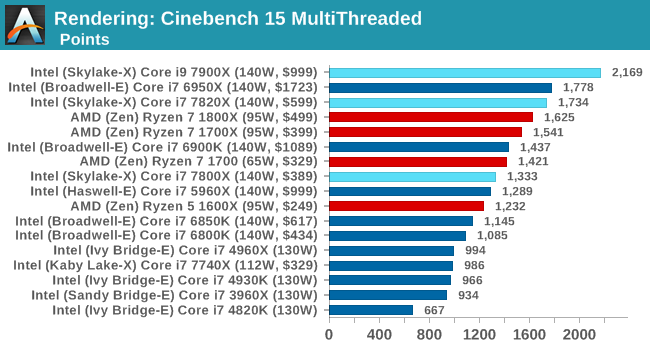
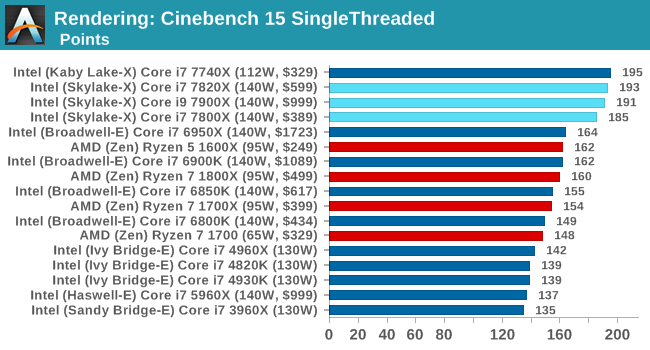










264 Comments
View All Comments
AnandTechReader2017 - Monday, June 19, 2017 - link
And no load/idle? And clockspeed at full load?Also, no mention of Intel drawing more than the rated load?
AnandTechReader2017 - Monday, June 19, 2017 - link
Sorry, missed the paragraph under on refresh.wolfemane - Monday, June 19, 2017 - link
Seriously... you don't post gaming results because of bios issues? Seems RYZEN had issues due to premature bios as well but that sure as hell didn't keep you all from posting results anyways.I was going to give kudos to you guys as I was reading the article for excluding gaming reaults on workstation CPU's. But nope, you had to add that little blurb there at the end.
Pretty god damn shameful if you ask me. Post the results, then do a follow up when venders get their crap together and release reliable bios. The same venders that blamed AMD for their inability to create half way decent bios.
Ryan Smith - Monday, June 19, 2017 - link
Unfortunately it's a bit of a damned if you do, damned if you don't situation for us. The Skylake-X platform is still quite immature in some respects, and Intel did not give us a ton of lead-time in testing it. The BIOSes only came in a bit before Ian had to get on a plane. So we've been racing the clock for the past week trying to pull things together.What we do have are a set of incomplete data that still shows some issues. But we need time to further validate that data, and even more time to write about it. Both of which have been in short supply over the last few days.
Mentioning gaming at all is because we wanted to point out that there are still issues, and that anyone who is primarily interested in gaming is likely best served by waiting, rather than jumping on Intel's pre-orders.
wolfemane - Monday, June 19, 2017 - link
I GET where you are coming from. But you (Anandtech) had no issues posting AMD Ryzen results knowing full well that the x370 platform was far *FAR* from mature. Anandtech and other reviewers didn't hesitate to mention all the bugs possibly holding the platform back. But you still posted the results. As you should have.Ian Cutress - Monday, June 19, 2017 - link
Err, what? Our Ryzen 7 review did not have gaming benchmarks.http://www.anandtech.com/show/11170/the-amd-zen-an...
wolfemane - Monday, June 19, 2017 - link
Well... guess how incredibly stupid I feel? If I could retract my comment I would. I'll go reread the launch review again.cheshirster - Monday, June 19, 2017 - link
No need to apologizeHere are gaming tests on DDR4-3000 @ 2400 downclocked memory
With Ryzens BADLY underperforming in RoTR and Rocket League pretty much published
http://www.anandtech.com/show/11244/the-amd-ryzen-...
And for Intel they write this
"Our GTX1080 seems to be hit the hardest out of our four GPUs, as well as Civilization 6, the second Rise of the Tomb Raider test, and Rocket League on all GPUs. As a result, we only posted a minor selection of results, most of which show good parity at 4K"
DanNeely - Monday, June 19, 2017 - link
Check the dates; that was published about 5 weeks after the initial Zen review that Ian linked to above. The initial one didn't have any gaming data yet; because in both cases the release day situation was too broken.melgross - Monday, June 19, 2017 - link
Yeah, it's usually considered to be proper to first read about what you're commenting upon.